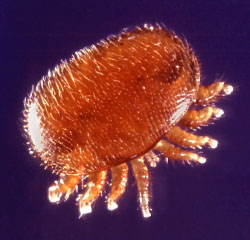Parasitism
Parasitism is a symbiotic relationship between two organisms where one organism (the parasite) gets benefit from the other organism (usually termed the 'host'). The parasite is detrimental to the host but doesn't kill it.
One example of a parasitic relationship is that of the varroa mite on honey bees. The small mite will attach to a foraging worker bee and catch a ride into the hive. Once there, it will burrow into a cell containing a larva and lay its eggs on it. When the larva pupates the eggs will hatch and the bee will leave the cell, taking the parasites with it. The mites feed on the bee's blood, weakening its immune system and transmitting diseases.

A photograph of a varroa mite (Varroa jacobsoni)
Photograph by Scott Bauer, USDA.
Related terms
- Brood parasitism
- Commensalism
- Ectoparasite
- Endoparasite
- Host
- Mutualism
- Parasite
- Symbiosis
- Varroa mite
Related groups of terms
Back to Glossary
If you have found this glossary useful please consider supporting the Amateur Entomologists' Society by becoming a member or making a donation.
![Amateur Entomologists' Society home page [Logo]](/images/aes-logo-wplant.gif)